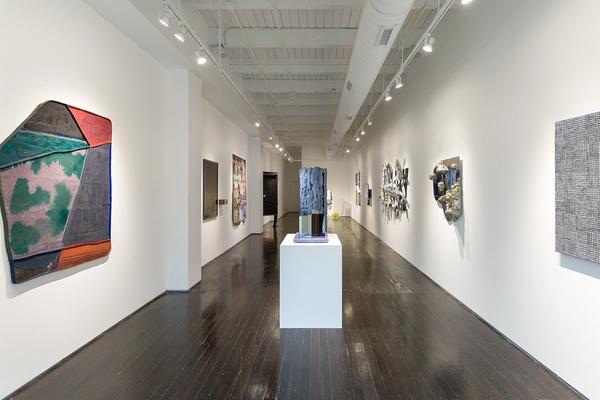
Press Release
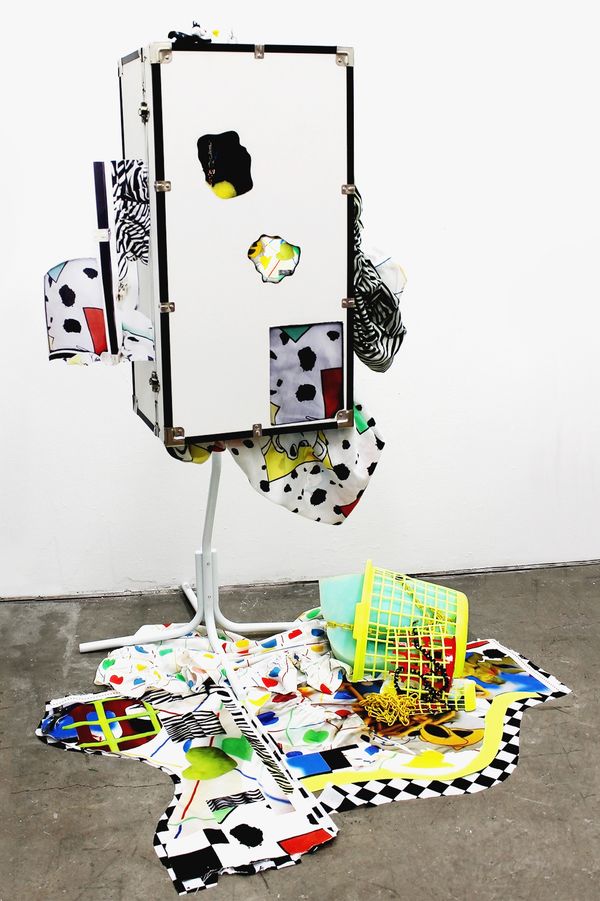
Martha Mysko
Latchkey Tweety, 2018
Curated by McArthur Binion, Homemade featured work from eleven emerging and established Detroit artists, spanning painting, mixed media, sculpture, sound and video. The son of cotton farmers, Binion moved to Detroit with his family at age 5 from Macon, MS; less than 20 years later, he received an MFA from the Cranbrook Academy of Art.
Homemade was conceived from Binion’s desire to reconnect with Detroit’s art scene in the present day, inspired by his formative years and the increasing recognition the city’s talents are finally receiving on a national scale. The exhibition presented Binion’s acclaimed investigations in personal abstraction as well as varied works by Scott Vincent Campbell, Jack Craig, Conrad Egyir, James Benjamin Franklin, Patrick Hill, Charles McGee, Martha Mysko, Patrick Quarm, Chris Schanck, and Maya Stovall. From recent graduates in painting to alumni of the Whitney Biennale and Detroit legends, Homemade brought together artists who have viewed the city as crucial to their creative output.
MCARTHUR BINION
McArthur Binion was born in rural Mississippi as the son of farmers in 1946, where he was put to work in the fields at a very early age. By 1950, his family of 12 moved to Detroit so that his father could pursue work in the auto industry. A writer early in his career, his education at Cranbrook eventually led him to combine the written word with painting, and he found his voice in the NY art scene combining collaged personal documents and oil stick to create autobiographical abstractions. Despite his unique ability to transform minimalism into personal history, it took decades for him to receive the recognition he deserved, though he often came close; as part of a 1973 show curated by Sol LeWitt, Carl Andre and Ronald Bladen, one of his works enclosed an address book page containing the names of Jean-Michel Basquiat and a number of top gallerists. The striking combination of typeset and handwritten elements with gridded formalism poses critical questions about identity and community, and especially prominent in Binion’s history is the undeniable evidence that as a black man - and a black artist - he spent much of his life restricted and overlooked.
SCOTT VINCENT CAMPBELL
Scott Vincent Campbell is a visual artist and curator who grew up between New York and Queens, Jamaica, and completed his BFA at Haverford College (PA) before moving to Detroit for the Red Bull House of Art residency program. Campbell found the Detroit artist community to be welcoming and supportive and has stayed on to be an active member in the city’s community, making his work at a studio space in Highland Park. Philosophical and exacting, his work draws from the duality of defence mechanisms that protect and comfort, while at the same time can be damaging and isolating. In particular, Campbell investigates the lies we tell ourselves - and those closest to us - to avoid dealing with difficult or inconvenient truths. Formally, he examines the physical structures used for safeguarding such as gates, fences, and masks; and allows fragments of vibrant red to peek through as a stand in for a swath of human emotion - anger, love, passion - and evidence that no armor is flawless. The matte black surface of his sculptures are dense and imposing, and rubber cord emerges from within, symbolizing the struggle to move past emotional barriers.
JACK CRAIG
Jack Craig first trained as an engineer (Bachelor and Master of Science, University of Maryland, 2001 and 2003) and later went on to obtain a degree in Industrial Design from the University of Illinois in 2010 and a Master of Fine Art in 3D Design at Cranbrook Academy of Art in 2012. He is a Visiting Artist at the School of the Art Institute of Chicago and has taught at a number of Metro Detroit schools including Lawrence Technological University and the University of Michigan. Craig’s studio practice is rooted in the manipulation of unconventional materials to create impromptu structures that span the categories of furniture, lighting, and installation. The use of unconventional material is characterized by a desire to shift observers’ understanding of everyday objects. Notable pieces include the ongoing PVC Series (2012-), where Craig heats and manipulates PVC watermain piping by hand, transforming and elevating an often-overlooked industrial material.
CONRAD EGYIR
Recent Cranbrook MFA (Painting) graduate Conrad Egyir was born and raised in Ghana, and draws from a pool of uniquely coded Ghanaian texts and visually based language systems. In an exploration of relationships between his past experiences in Africa and his present residence in the United States, he is drawn to themes that define the past and present, the image and self, predestination and free will. His practice analyzes the relationship between the symbols and history of these themes, and addresses the complexity of merging a postcolonial upbringing and western higher education. Woven into his works are borrowed superstitious and symbolic aesthetics from West Africa, misrememberences from varied cultures, and a deconstruction and redefining of colorism and identity. Egyir uses subjects that do not fit into the timelines or settings of the stories he draws from, often interchanging a character’s gender, social status, or age. The artist regularly uses his own image as a template for his figures, creating a singular figure that transcends its narrative - simultaneously the victim and perpetrator, father and son, friend and foe.
JAMES BENJAMIN FRANKLIN
James Benjamin Franklin graduated from Art Center College of Design in 1999, and in 2017 completed his MFA at the Cranbrook Academy of Art. He builds flat, shaped forms out of plaster cloth and adorns them with loud patterns and bright colors, creating a playful dialogue between shape, texture and palette. The form of the plaster cloth elements and their surfaces are rough - even awkward at times - bringing a dynamic energy that extends beyond the work to impress upon the space that it inhabits. Franklin’s overt demonstration of his practice invites the viewer to explore his creative process; layers, drips, and splatters are left as evidence of the artist’s hand and his steady attention to materials and texture.
PATRICK HILL
Patrick Hill was born in Royal Oak, MI, and earned his BFA from the University of Michigan before a Masters at the Otis College of Art and Design in Los Angeles. After spending over a decade in LA, Hill participated in the 2008 Whitney Biennale, and later returned to Detroit to continue his practice as a sculptor and expand his curatorial vision at his garage-turned-gallery, Southfield. Hill’s art is intuitive, personal, and cathartic. Largely abstract and often utilizing geometry and minimalism as a vehicle to address notions of autobiography, spirituality and sacred spaces, art and design history, popular culture and malady. His work is full of dichotomies; from material choices, through process and construction, carrying visual weight and ethereality all at once. This is most apparent in his use of delicate paper and fabrics - which readily absorb inks and dyes to explore transience and issues around the body - set in connection to hard elements like glass, steel and stone that reference architecture, mortuaries, and permanence. For the exhibition, Hill has created a work of smoked glass and mirror planes set in a dyed carrara marble base that seems to levitate off its pedestal. Its placement in the gallery collects natural light and creates an apparitional experience as it is explored in the round.
CHARLES MCGEE
Charles McGee was born in 1924 and has lived in Detroit since the age of 10. His career has spanned over 70 years, with a focus on enduring themes such as the black experience and his love of nature. Working in a variety of mediums, McGee’s practice ranges from charcoal drawings and photography to avant-garde three-dimensional and multimedia pieces. His work can be seen around Detroit and the metro area, including at the William Beaumont Hospital in Royal Oak; the Detroit People Mover Broadway Station; and most recently the 118’ 6” H x 50’ 9” W mural, titled Unity, that adorns the north side of 28 Grand Blvd. McGee’s works are on permanent display at the Detroit Institute of Arts and the Charles H. Wright Museum of African American History. Nationally, he has shown at the Brooklyn Museum and Whitney Museum of American Art, and in touring exhibitions under the umbrellas of the Smithsonian and Corcoran Gallery of Art of Washington D.C.
MARTHA MYSKO
Martha Mysko received a BFA in painting at Towson University, MD in 2004, and an MFA from Cranbrook Academy of Art’s painting program in 2011. Her studio practice is based in mixed-media, site-specific installations. Mysko re-appropriates forgotten objects and combines them with digital media into complex, colorful, and often whimsical scenes. Her studio practice contorts and controls space in which the viewer becomes an active participant, often completing the scene or setting. For Homemade, Mysko has created a sculpture out of a palette of primary colors and flea market objects that references pop and items discarded to the basement. She first sourced Tweety Bird merchandise, and then allowed other materials, iconography and processes to move in and out of the work’s vocabulary - 101 Dalmations, bird cages, the Lifetime Movie Network, JC Penney, Amazon, Mondrian, storage, laundry, toys, dust, past and present tense. Working between abstraction and representation, Mysko’s reimagining of familiar objects and materials of the everyday to question ideas of taste and value.
PATRICK QUARM
Patrick Quarm graduated from Kwame Nkrumah University of Science and Technology, Ghana with a BFA in painting (2012) and a MFA from Texas Tech University (2018). Quarm’s work investigates the intersection of his identity both as an African and as an American, through representational portraiture, complex pattern work, and textiles that are rich with color and cultural complexity. Quarm’s use of oil paint and collage on fabric gives his work a three-dimensional, layered effect that lends movement beyond the two dimensional surface. Quarm’s fabrics are shipped from family in Ghana, but the artist explains that the textile itself has a complicated history as it originates from Indonesia. “The reason I use this fabric is because it’s African, but it’s not African,” says Quarm. Like the fabric, Quarm continuously questions authenticity in identity; how communities shape identity through the relationship to place; and whether place is a valid form of establishing identity at all.
CHRIS SCHANCK
Detroit-based designer Chris Schanck embraces contradiction in his work, finding a comfortable place between the distinctions of dilapidation and assemblage, individual and collective, industrial and handcraft, romanticism and cynicism. His efforts deviate from the mass-produced, instead reviving mundane materials by transforming them into unique objects of uncommon luxury. Schanck is perhaps best known for his “Alufoil” series, in which industrial and discarded materials are sculpted, covered in aluminum foil and then sealed with resin. Schanck received a B.F.A. from the School of Visual Arts in Sculpture and an M.F.A in Design from Cranbrook Academy of Art. In 2011, Schanck moved to Detroit and founded a burgeoning studio employing over a dozen artists, students and Craftsmen.
MAYA STOVALL
Maya Stovall employs a mix of anthropological observation and urban intervention to create performance-based works that investigate ethnography. Stovall grew up in Detroit and has focused significantly on the landscape of her home, as demonstrated in her Liquor Store Theatre series as part of the 2017 Whitney Biennial. The subjects in this work are her neighbors in the McDougall-Hunt area on the city’s east side, where she dances outside neighborhood liquor stores before inviting her audience - the establishments’ patrons and other passersby - to share their recollections of and predictions for Detroit. The stores serve as hubs of commerce and community, “a backstage view of ongoing life in a neighborhood, in spite of narratives of abandonment.” For Homemade, Stovall has created an illusionistic piece from store signage accompanied by found sound.
Homemade, on display from October 27, 2018 through January 12, 2019.
Install Images
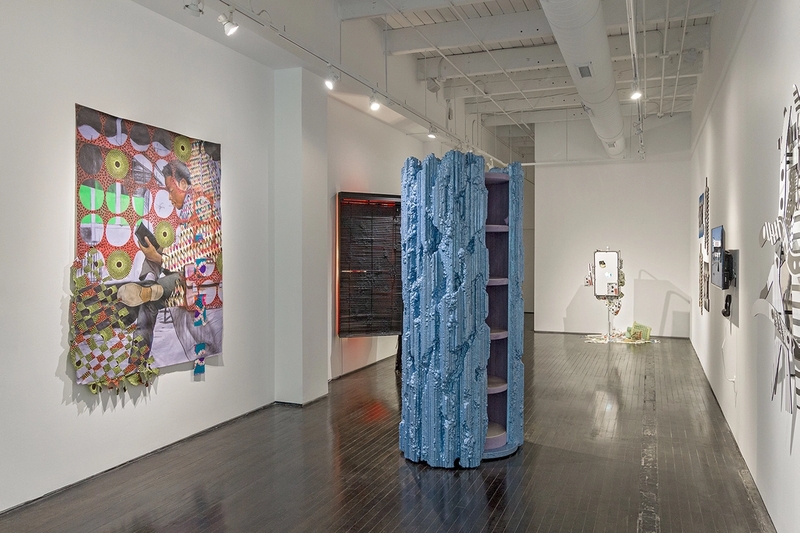

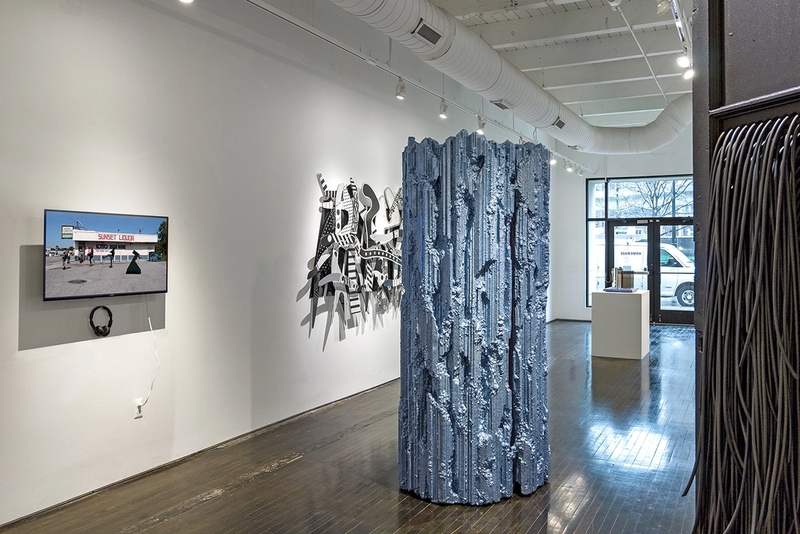
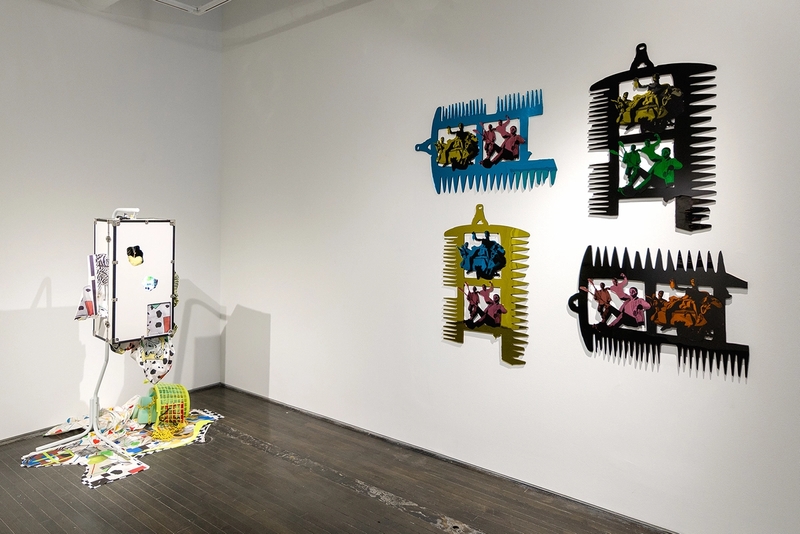

Artwork Images

Charles McGee
Rhapsody in Black and White, 2008
Ultraviolet ink-jet spray system on dibond
60h x 108w inches

James Benjamin Franklin
WHOLE IN THE DUST, 2018
Acrylic, fabric and apoxie sculpt on reinforced rigid wrap
57.5h x 47.5w x 1.25d inches

Maya Stovall
Liquor Store Theatre, vol. 4, no. 7, 2017
Courtesy the artist and Todd Stovall. Pictured performers include Seycon-Nadia Chea and Mohamed Soumah with the artist.